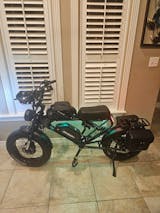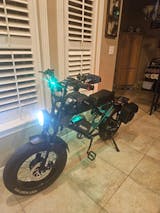Table of Contents
- 1. What is a Hub Drive Ebike?
- 2. What is a Dual Motor Ebike?
- 3. Performance Comparison: Which One Rides Better?
- 4. Maintenance & Longevity
- Hub Drive Ebikes: Low Maintenance & Simplicity
- Dual Motor Ebikes: More Components, More Wear
- Battery Lifespan
- 5. Cost & Value: Which is Worth It?
- Hub Drive Ebikes: Budget-Friendly & Practical
- Dual Motor Ebikes: Higher Cost, Greater Capability
- Long-Term Value
- 6. Conclusion: Which One Should You Choose?
- 7. FAQs
The selection of an ebike motor system determines both performance quality and efficiency attributes and terrain navigation capabilities. The two main types are hub drive Ebikes and dual motor Ebikes, each with distinct advantages.
A hub drive ebike incorporates a sole motor that positions either in the front wheel or the rear wheel. Hub drive ebikes provide the advantage of light weight alongside high efficiency for urban environments although they lack proper performance on hills as well as challenging surfaces. Dual motor ebikes contain two motors installed on their wheels which provides them with improved torque output and enhanced traction as well as superior off-road abilities.
The knowledge of motor positioning between hub and dual systems provides riders all essential information to choose equipment that suits their requirements. This guide supports readers in selecting their ideal ebike by breaking down essential aspects such as motor capabilities, efficiency, battery life, maintenance aspects and cost.
1. What is a Hub Drive Ebike?
A hub drive Ebike uses a motor built into either the front or rear wheel. This motor directly powers the wheel without relying on the bike’s drivetrain. Rear hub motors offer better traction and balance, while front hub motors create a more neutral ride feel. Power delivery is smooth, making hub motors a reliable choice for commuting and casual riding.
Pros of Hub Drive Ebikes
- Simple design: Fewer moving parts mean lower maintenance.
- Energy-efficient: Consumes less battery compared to dual motor setups.
- Great for urban riding: Works best on paved roads and bike lanes.
Cons of Hub Drive Ebikes
- Limited torque: Slower acceleration and reduced climbing power.
- Struggles on steep hills: Single-motor power may not be enough for inclines.
- Single-wheel traction: Can slip on wet or loose surfaces.
Hub drive Ebikes are best for city commuting, recreational cycling, and riders looking for an affordable, low-maintenance option.
2. What is a Dual Motor Ebike?
Users benefit from the benefits of two motors installed on wheels that help distribute power evenly. The two-motor system of dual motors provides superior control over hub drive ebikes since they give better torque and traction during difficult terrain conditions. The configuration improves stability alongside better control which works best on steep slopes along with loose surfaces and rough terrain areas.
Pros of Dual Motor Ebikes
- Higher torque: Provides stronger acceleration and better hill-climbing ability.
- Improved traction: Both wheels engage, reducing slippage on uneven terrain.
- Ideal for off-road riding: Performs well on mountain trails, sand, snow, and wet surfaces.
Cons of Dual Motor Ebikes
- Heavier: Additional motor weight makes handling slightly more demanding.
- Increased battery drain: More power consumption leads to shorter riding range.
- Higher cost: More complex systems mean higher upfront and maintenance costs.
Dual motor ebikes are perfect for off-road enthusiasts, riders tackling extreme conditions, and those needing maximum power and stability.
3. Performance Comparison: Which One Rides Better?
When comparing dual motor ebikes and hub drive ebikes, performance depends on power, efficiency, and terrain adaptability. Each system offers advantages, but the right choice depends on where and how you ride.
Speed & Torque
Dual motor ebikes deliver higher torque and acceleration, making them ideal for climbing hills and riding off-road. With power distributed across both wheels, they provide better control and responsiveness. Hub drive ebikes, in contrast, are more energy-efficient and offer a smoother ride on flat terrain, but they may struggle with steep inclines due to lower torque.
Terrain Adaptability
If you primarily ride on paved roads or bike paths, a hub drive ebike is a solid choice. It performs well in urban settings and offers a lightweight, easy-to-handle experience. Dual motor ebikes excel in rough terrain, sand, snow, and wet conditions, where extra traction and stability are necessary.
Battery Life & Efficiency
A hub motor ebike consumes less power, making it ideal for longer commutes with minimal battery drain. A dual motor ebike, however, drains the battery faster due to increased power demands, reducing overall range. Riders who prioritize efficiency may prefer hub motors, while those needing power and performance will benefit from a dual motor setup.
4. Maintenance & Longevity
The lifespan and upkeep of an ebike depend largely on its motor system. Hub drive ebikes are simpler, requiring less maintenance, while dual motor ebikes have more components that wear down over time. Understanding these differences helps riders choose a system that aligns with their maintenance preferences.
Hub Drive Ebikes: Low Maintenance & Simplicity
Due to its fewer components the hub drive ebike reduces maintenance requirements during the years it operates. Hub motors operate independently inside their hubs thus they deliver minimal mechanical stress to drivetrain and cassette systems. The number of breakdowns decreases while mechanical parts last longer due to this design. A hub drive electric bike can stay in good condition through standard inspections of tires, brakes and battery patterns.
Dual Motor Ebikes: More Components, More Wear
With two motors, extra wiring, and additional strain on the drivetrain, dual motor ebikes require more maintenance. The added torque and power output can wear down chains, gears, and bearings faster than a single hub motor system. Regular servicing is crucial to prevent overheating, misalignment, or power inconsistencies.
Battery Lifespan
Hub drive ebikes consume less power, leading to longer battery life. Dual motor ebikes drain batteries faster, meaning frequent recharges and potential battery replacement sooner. Riders prioritizing low maintenance and longevity may prefer hub drive systems.
5. Cost & Value: Which is Worth It?
The price of an ebike depends largely on its motor system. Hub drive ebikes are more affordable and cost-effective, while dual motor ebikes come at a higher price but provide better performance for demanding terrain. Choosing the right one depends on budget, riding needs, and long-term value.
Hub Drive Ebikes: Budget-Friendly & Practical
A hub drive ebike is the best choice for budget-conscious riders. With fewer components and simpler mechanics, these bikes generally cost between $800 and $2,500, depending on battery capacity and motor power. They offer great value for urban commuting, casual riding, and long-distance travel, with lower maintenance costs over time.
Dual Motor Ebikes: Higher Cost, Greater Capability
Dual motor electric bicycles range in cost from $2,500 up to $6,000+ because they include two motors and stronger construction and complex electronic components. Off-road enthusiasts, adventure riders together with people who require additional traction on rough surfaces gain justification from superior power delivered by dual motor ebikes which makes the price reasonable. The increased expense of maintenance will cost more money while the batteries require replacement earlier than expected.
Long-Term Value
For city riders and commuters, a hub drive ebike offers the best cost-to-performance ratio. For those riding on mountain trails, sand, or snow, a dual motor ebike is worth the investment for power and durability.
6. Conclusion: Which One Should You Choose?
The best ebike motor system depends on where and how you ride. Both hub drive ebikes and dual motor ebikes serve different needs, offering distinct advantages.
Best for Commuters: Hub Drive Ebikes
People who travel on bike lanes together with paved roads and cityscapes should select a hub drive ebike because it makes the most financial sense. The bike is budget-friendly with efficient power usage and minimal care needs which suits overall travel and leisure usages.
Best for Off-Road Riders: Dual Motor Ebikes
When facing steep inclines along with rough trails combined with extreme conditions users should select a dual motor ebike instead. The twin motor design delivers enhanced torque power as well as exceptional traction neither of which exists in single motor systems.
Ultimately, your choice should align with your riding style, budget, and terrain needs. Prioritize efficiency for city riding or power for adventure cycling to get the best value from your ebike.
7. FAQs
1) Are dual motor ebikes faster than hub drive ebikes?
Dual motor ebikes offer more torque and acceleration, but they are not necessarily faster. Speed depends on motor wattage, battery capacity, and gearing. Many hub drive ebikes can reach the same top speed as dual motor ebikes, but the latter performs better on steep hills and rough terrain.
2) Do dual motor ebikes drain the battery faster?
Yes, dual motor ebikes consume more power since two motors draw energy simultaneously. This leads to shorter range per charge compared to hub drive ebikes, which use power more efficiently. Riders can extend battery life by using eco modes, regenerative braking, and carrying an extra battery for long trips.
3) Which type of ebike requires more maintenance?
Dual motor ebikes need more maintenance due to extra wiring, drivetrain stress, and higher power output, which wears down components faster. Hub drive ebikes have a simpler design with fewer moving parts, reducing upkeep. If you prefer a low-maintenance, cost-effective option, a hub drive ebike is the better choice.




















